Public Art at MRT Construction
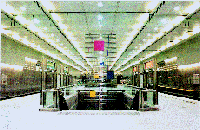 Public art can be simply defined as art in public space. The space is usually open and accessible to the public. Public art should be site-specific and combined with its surroundings while at the same time being intimate, diverse, interesting and safe for the public. MRT public art should properly express the special characteristics of local cultural concerns and regional features. It should not only be beneficial in improving spatial quality, plus providing pleasant scenery and environment, but also express local culture and historic background, enhance passengers' recognition of places, and furthermore, gain public empathy and become part of daily life.
Public art can be simply defined as art in public space. The space is usually open and accessible to the public. Public art should be site-specific and combined with its surroundings while at the same time being intimate, diverse, interesting and safe for the public. MRT public art should properly express the special characteristics of local cultural concerns and regional features. It should not only be beneficial in improving spatial quality, plus providing pleasant scenery and environment, but also express local culture and historic background, enhance passengers' recognition of places, and furthermore, gain public empathy and become part of daily life.
Planning Process
Before the "Statute on Encouraging and Rewarding Cultural and Art Enterprises" was promulgated on July 1, 1992, DORTS was already aware that the issue of the integration of public art and construction would soon have to be considered. DORTS has been working on an implementation strategy for installing public art in MRT stations since 1980. In 1991, DORTS invited scholars and experts to a symposium called the "Implementation Plan for the Integration of MRT Construction and Arts." The following year, DORTS established a special project on MRT public art. The goals of the project were to enhance the quality of MRT space, strengthen the local context of stations, and encourage a feeling of intimacy towards MRT construction. In early 1993, the Public Art Evaluation Committee, which was composed of experts and scholars from the fields of art, architecture, landscaping and art media, was established by DORTS to help select and evaluate public art.
Public Art on the Initial Network
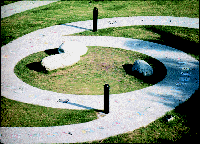 On the initial network, DORTS selected important stations such as intersection stations, terminals and stations with heavy passenger flow, for the installation of public artworks. The principles behind the location of public art were visual focus and non-interference with passenger circulation and construction schedules. The artworks included murals, children's mosaic collages, sculptures, hung forms, spatial art, interactive art, and window displays. The selection methods included open competitions, invitational competitions, direct assignments, and cooperation with children. Various public participation methods were used to shorten the distance between public art and the public. Fifteen artworks have been completed. Details of these artworks are provided on the List of Public Art.
On the initial network, DORTS selected important stations such as intersection stations, terminals and stations with heavy passenger flow, for the installation of public artworks. The principles behind the location of public art were visual focus and non-interference with passenger circulation and construction schedules. The artworks included murals, children's mosaic collages, sculptures, hung forms, spatial art, interactive art, and window displays. The selection methods included open competitions, invitational competitions, direct assignments, and cooperation with children. Various public participation methods were used to shorten the distance between public art and the public. Fifteen artworks have been completed. Details of these artworks are provided on the List of Public Art.
The Station as a Work of Art
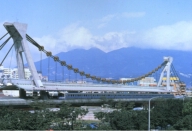 On the Tamsui line, many stations are works of art by themselves. The elevated stations use modern materials to reflect a traditional Chinese architectural style, such as using stainless steel to create Chinese-style window rails, using steel to construct the supporting structure in the style of a Chinese roof as well as using curved or steep roofs to express the individuality of each station. The sky windows at the entrance lobby of each ground-level station accentuate the effects of changes of light in the lobbies. Furthermore, Jiantan Station expresses the beauty of structure with its cable system; Beitou Station emphasizes its advanced technology with its space frame; Tamsui Station reflects the local context with its local architectural language. In addition to being selected by the public as one of the key landmarks of Taipei, Jiantan Station also won an award from Architect magazine in 1997.
On the Tamsui line, many stations are works of art by themselves. The elevated stations use modern materials to reflect a traditional Chinese architectural style, such as using stainless steel to create Chinese-style window rails, using steel to construct the supporting structure in the style of a Chinese roof as well as using curved or steep roofs to express the individuality of each station. The sky windows at the entrance lobby of each ground-level station accentuate the effects of changes of light in the lobbies. Furthermore, Jiantan Station expresses the beauty of structure with its cable system; Beitou Station emphasizes its advanced technology with its space frame; Tamsui Station reflects the local context with its local architectural language. In addition to being selected by the public as one of the key landmarks of Taipei, Jiantan Station also won an award from Architect magazine in 1997.
Public Art on the Long-term Network
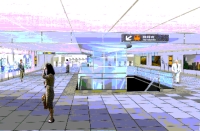 DORTS understands the importance of taking public art into consideration at the design stage. Therefore, in the general scope of service of the detailed design consultants for the long-term MRT network, DORTS stipulated that the consultant team must include a public art curator. The public art curator will be in charge of all business related to public art and act as coordinator between artists and architects. The public art curator should propose a public art plan, which includes the themes, locations, types and selection methods of artworks in order to integrate them effectively, as well as the details of the execution plan, which will be approved by the related committee and implemented one year before the station finishing work begins. The expectation is to integrate public art into its surroundings and display both as a whole. Incidentally, public art is by no means limited to sculpture. It can be combined with walls, floors, ceilings, lighting, images, sound, signage, station furniture and equipment, etc. In other words, all elements of the environment can be pieces of art. Thus, public art can be perfectly integrated into the architecture to achieve the eternal goals of making an environment artistic and making art environmental.
DORTS understands the importance of taking public art into consideration at the design stage. Therefore, in the general scope of service of the detailed design consultants for the long-term MRT network, DORTS stipulated that the consultant team must include a public art curator. The public art curator will be in charge of all business related to public art and act as coordinator between artists and architects. The public art curator should propose a public art plan, which includes the themes, locations, types and selection methods of artworks in order to integrate them effectively, as well as the details of the execution plan, which will be approved by the related committee and implemented one year before the station finishing work begins. The expectation is to integrate public art into its surroundings and display both as a whole. Incidentally, public art is by no means limited to sculpture. It can be combined with walls, floors, ceilings, lighting, images, sound, signage, station furniture and equipment, etc. In other words, all elements of the environment can be pieces of art. Thus, public art can be perfectly integrated into the architecture to achieve the eternal goals of making an environment artistic and making art environmental.
Conclusion
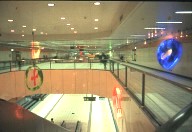 DORTS initially implemented its public art procedures before the "Statute on Encouraging and Rewarding Cultural and Art Enterprises" was promulgated. The execution methods of public art, from selection of important stations on the initial network to installation of public art and reservation of locations for public art on the long-term network, are fully flexible and can be adjusted anytime to match practical needs as well as current trends, and to honor the past and look forward to the future. In addition to pursuing high quality construction, DORTS expects that the public, while enjoying the comfort and convenience of the MRT system, can also sense its concern and enthusiasm for public art.
DORTS initially implemented its public art procedures before the "Statute on Encouraging and Rewarding Cultural and Art Enterprises" was promulgated. The execution methods of public art, from selection of important stations on the initial network to installation of public art and reservation of locations for public art on the long-term network, are fully flexible and can be adjusted anytime to match practical needs as well as current trends, and to honor the past and look forward to the future. In addition to pursuing high quality construction, DORTS expects that the public, while enjoying the comfort and convenience of the MRT system, can also sense its concern and enthusiasm for public art.
 Public art can be simply defined as art in public space. The space is usually open and accessible to the public. Public art should be site-specific and combined with its surroundings while at the same time being intimate, diverse, interesting and safe for the public. MRT public art should properly express the special characteristics of local cultural concerns and regional features. It should not only be beneficial in improving spatial quality, plus providing pleasant scenery and environment, but also express local culture and historic background, enhance passengers' recognition of places, and furthermore, gain public empathy and become part of daily life.
Public art can be simply defined as art in public space. The space is usually open and accessible to the public. Public art should be site-specific and combined with its surroundings while at the same time being intimate, diverse, interesting and safe for the public. MRT public art should properly express the special characteristics of local cultural concerns and regional features. It should not only be beneficial in improving spatial quality, plus providing pleasant scenery and environment, but also express local culture and historic background, enhance passengers' recognition of places, and furthermore, gain public empathy and become part of daily life. On the initial network, DORTS selected important stations such as intersection stations, terminals and stations with heavy passenger flow, for the installation of public artworks. The principles behind the location of public art were visual focus and non-interference with passenger circulation and construction schedules. The artworks included murals, children's mosaic collages, sculptures, hung forms, spatial art, interactive art, and window displays. The selection methods included open competitions, invitational competitions, direct assignments, and cooperation with children. Various public participation methods were used to shorten the distance between public art and the public. Fifteen artworks have been completed. Details of these artworks are provided on the List of Public Art.
On the initial network, DORTS selected important stations such as intersection stations, terminals and stations with heavy passenger flow, for the installation of public artworks. The principles behind the location of public art were visual focus and non-interference with passenger circulation and construction schedules. The artworks included murals, children's mosaic collages, sculptures, hung forms, spatial art, interactive art, and window displays. The selection methods included open competitions, invitational competitions, direct assignments, and cooperation with children. Various public participation methods were used to shorten the distance between public art and the public. Fifteen artworks have been completed. Details of these artworks are provided on the List of Public Art. On the Tamsui line, many stations are works of art by themselves. The elevated stations use modern materials to reflect a traditional Chinese architectural style, such as using stainless steel to create Chinese-style window rails, using steel to construct the supporting structure in the style of a Chinese roof as well as using curved or steep roofs to express the individuality of each station. The sky windows at the entrance lobby of each ground-level station accentuate the effects of changes of light in the lobbies. Furthermore, Jiantan Station expresses the beauty of structure with its cable system; Beitou Station emphasizes its advanced technology with its space frame; Tamsui Station reflects the local context with its local architectural language. In addition to being selected by the public as one of the key landmarks of Taipei, Jiantan Station also won an award from Architect magazine in 1997.
On the Tamsui line, many stations are works of art by themselves. The elevated stations use modern materials to reflect a traditional Chinese architectural style, such as using stainless steel to create Chinese-style window rails, using steel to construct the supporting structure in the style of a Chinese roof as well as using curved or steep roofs to express the individuality of each station. The sky windows at the entrance lobby of each ground-level station accentuate the effects of changes of light in the lobbies. Furthermore, Jiantan Station expresses the beauty of structure with its cable system; Beitou Station emphasizes its advanced technology with its space frame; Tamsui Station reflects the local context with its local architectural language. In addition to being selected by the public as one of the key landmarks of Taipei, Jiantan Station also won an award from Architect magazine in 1997. DORTS understands the importance of taking public art into consideration at the design stage. Therefore, in the general scope of service of the detailed design consultants for the long-term MRT network, DORTS stipulated that the consultant team must include a public art curator. The public art curator will be in charge of all business related to public art and act as coordinator between artists and architects. The public art curator should propose a public art plan, which includes the themes, locations, types and selection methods of artworks in order to integrate them effectively, as well as the details of the execution plan, which will be approved by the related committee and implemented one year before the station finishing work begins. The expectation is to integrate public art into its surroundings and display both as a whole. Incidentally, public art is by no means limited to sculpture. It can be combined with walls, floors, ceilings, lighting, images, sound, signage, station furniture and equipment, etc. In other words, all elements of the environment can be pieces of art. Thus, public art can be perfectly integrated into the architecture to achieve the eternal goals of making an environment artistic and making art environmental.
DORTS understands the importance of taking public art into consideration at the design stage. Therefore, in the general scope of service of the detailed design consultants for the long-term MRT network, DORTS stipulated that the consultant team must include a public art curator. The public art curator will be in charge of all business related to public art and act as coordinator between artists and architects. The public art curator should propose a public art plan, which includes the themes, locations, types and selection methods of artworks in order to integrate them effectively, as well as the details of the execution plan, which will be approved by the related committee and implemented one year before the station finishing work begins. The expectation is to integrate public art into its surroundings and display both as a whole. Incidentally, public art is by no means limited to sculpture. It can be combined with walls, floors, ceilings, lighting, images, sound, signage, station furniture and equipment, etc. In other words, all elements of the environment can be pieces of art. Thus, public art can be perfectly integrated into the architecture to achieve the eternal goals of making an environment artistic and making art environmental. DORTS initially implemented its public art procedures before the "Statute on Encouraging and Rewarding Cultural and Art Enterprises" was promulgated. The execution methods of public art, from selection of important stations on the initial network to installation of public art and reservation of locations for public art on the long-term network, are fully flexible and can be adjusted anytime to match practical needs as well as current trends, and to honor the past and look forward to the future. In addition to pursuing high quality construction, DORTS expects that the public, while enjoying the comfort and convenience of the MRT system, can also sense its concern and enthusiasm for public art.
DORTS initially implemented its public art procedures before the "Statute on Encouraging and Rewarding Cultural and Art Enterprises" was promulgated. The execution methods of public art, from selection of important stations on the initial network to installation of public art and reservation of locations for public art on the long-term network, are fully flexible and can be adjusted anytime to match practical needs as well as current trends, and to honor the past and look forward to the future. In addition to pursuing high quality construction, DORTS expects that the public, while enjoying the comfort and convenience of the MRT system, can also sense its concern and enthusiasm for public art.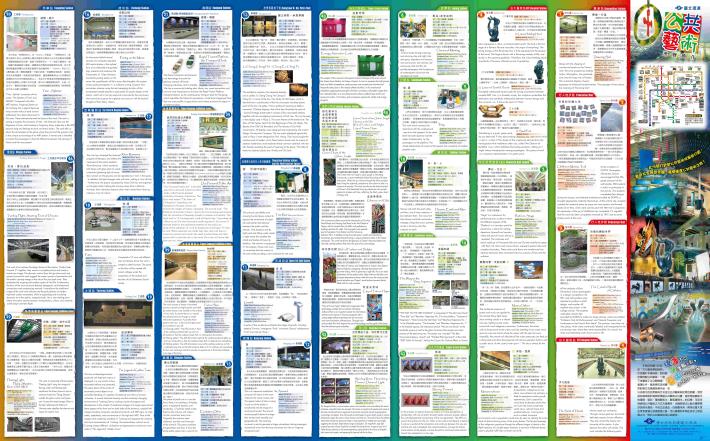
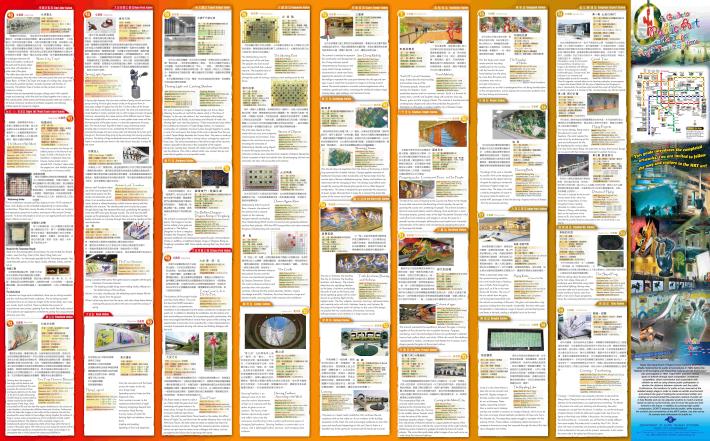

![Taiwan.gov.tw [ open a new window]](/images/egov.png)
